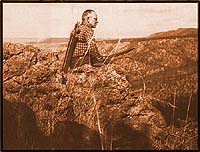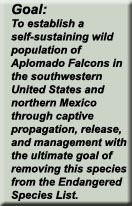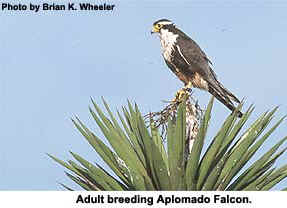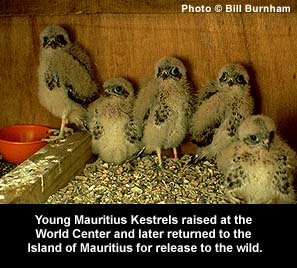

Conservation
Lectures 29-
29 March - ??
Conservation
Background and theory
Avian
Perspective -
how
many bird species extant?
how
many thought to have existed
calculate
extinction rate 90,000/130,000,000 yrs = .00069
why
bother worrying about a few more?
Conservation biology -
Class-define
biodiversity
species
level 30-100 x 106 species - can cons. bio. be species based?
population
level -
sources
sinks
metapopulations
system
level
species
interactions
fragmentation
roots of Conservation Biology
Romantic-transendental
Conservation Ethic of preservation
Throreau,
Emerson, Muir 1800s
Resource
Conservation Ethic - Gifford Pinchot
1900
- US Forest Service
Evolutionary-Ecological
Land Ethic
1930s
- Aldo Leopold
Aldo
Leopold (1887-1948) is considered the father of wildlife ecology and a true
Wisconsin hero. He was a renowned scientist and scholar, exceptional teacher,
philosopher, and gifted writer.
It is for his book, A Sand County Almanac, that Leopold is best known by
millions of people around the globe. The Almanac,
 often acclaimed as the century's literary landmark in conservation, melds
exceptional poetic prose with keen observations of the natural world. The
Almanac reflects an evolution of a lifetime of love, observation, and thought.
It led to a philosophy that has guided many to discovering what it means to live
in harmony with the land and with one another.
often acclaimed as the century's literary landmark in conservation, melds
exceptional poetic prose with keen observations of the natural world. The
Almanac reflects an evolution of a lifetime of love, observation, and thought.
It led to a philosophy that has guided many to discovering what it means to live
in harmony with the land and with one another.
The roots of Leopold's concept of a "land ethic" can be traced to his
birthplace on the bluffs of the Mississippi River near Burlington, Iowa. As a
youngster, he developed a zealous appreciation and interest in the natural
world, spending countless hours on adventures in the woods, prairies, and river
backwaters of a then relatively wild Iowa. This early attachment to the natural
world, coupled with an uncommon skill for both observation and writing, lead him
to pursue a degree in forestry at Yale.
After Yale, Leopold joined the U.S. Forest Service and was assigned to the
Arizona Territories. During his tenure, he began to see the land as a living
organism and develop the concept of community. This concept became the
foundation upon which he became conservation's most influential advocate. In
1924, he accepted a transfer to the U.S. Forest Products Laboratory in Madison
where he served as associate director, and began teaching at the University of
Wisconsin in 1928.
Often credited as the founding father of wildlife ecology, Leopold's cornerstone
book Game Management (1933) defined the fundamental skills and techniques for
managing and restoring wildlife populations. This landmark work created a new
science that intertwined forestry, agriculture, biology, zoology, ecology,
education and communication. Soon after its publication, the University of
Wisconsin created a new department, the Department of Game Management, and
appointed Leopold as its first chair.
Leopold's unique gift for communicating scientific concepts was only equal to
his fervor for putting theories into practice. In 1935, the Leopold family
purchased a worn-out farm near Baraboo, in an area known as the sand counties.
It is here Leopold put into action his beliefs that the same tools people used
to disrupt the landscape could also be used to rebuild it. An old chicken coop,
fondly known as the Shack, served as a haven and land laboratory for the Leopold
family, friends, and graduate students. And it was here Leopold visualized many
of the essays of what was to become his most influential work, A Sand County
Almanac.
The Land Ethic
"The land ethic simply enlarges the boundaries of the community to include
soils, waters, plants, and animals, or collectively: the land.
"The Land Ethic" from A Sand County Almanac
Passenger Pigeon, extinct
We have erected a monument to commemorate the funeral of a species. It
symbolizes our sorrow. We grieve because no living man will see again the
onrushing phalanx of victorious birds, sweeping a path for spring across the
March skies, chasing the defeated winter from the woods and prairies of
Wisconsin.
Men still live who, in their youth, remember pigeons. Trees still live who, in their youth, were shaken by a living wind. But a decade hence only the oldest oaks will remember, and at long last only the hills will know. ...
The pigeon was a biological storm. He was the lightening that played between
two opposing potentials of intolerable intensity: the fat of the land and the
oxygen of the air.
"Wisconsin" in A Sand County Almanac
Food and Fuel
There are two spiritual dangers in not owning a farm. One is the danger of
supposing that breakfast comes from the grocery, and the other that heat comes
from the furnace.
To avoid the first danger, one should plant a garden, preferably where there is no grocer to confuse the issue.
To avoid the second, he should lay a split of good oak on the andirons,
preferably where there is no furnace, and let it warm his shins while a February
blizzard tosses the trees outside.
"February" in A Sand County Almanac
![]()
Conservation
Biology is:
crisis discipline
manage endangered species
define critical population sizes
define habitat requirements
manage corridors?
wrestle with economics -
how
much does it cost to save a species?
can
species or habitat be accurately priced?
What make species vulnerable?
large size =
low
population size
slow
reproductive rate
top order predators - accumulate toxins
restricted range =
low
numbers
susceptible
habitat
destruction
disease/predation
natural
introduced
hunting/trapping
physical attributes
good looks -
Snowy Egrets
parrots in general, etc.
good
taste
flightlessness
low numbers alone doesn’t guarantee threatened status
Passenger Pigeon numbered 2 billion
Eskimo Curlew
since 1600 = 92 extinctions
91%
partly due to introduced spp
32%
partly due to habitat change (Bachman’s Warbler in 1960s)
25%
partly due to human hunting
Modern threats
habitat loss
scrubland
urban
sprawl
grazing
rainforest
14->7%
land area
>>50% of species
coffee
plantations - Neotropical Migrants.
Shade-Grown Coffee
•Migratory birds and many resident birds find sanctuary in the forest canopy of traditional coffee plantations.
•Shade trees protect the plants from rain and sun, help maintain soil quality, and aid in natural pest control, thanks to the birds.
•Traditional coffee plantations help to conserve watersheds, leading to higher water quality and quantity for local populations.
•Shade-grown coffee is cultivated in specific ways that help protect biodiversity.
•Shade coffee plants can produce crops of beans for up to 50 years.
Sun-Grown Coffee
•90% fewer bird species are found in sun-grown coffee areas compared with shade-grown coffee areas.
•Requires chemical fertilizers and pesticides and year-round labor, placing financial demands on the growers.
•Leads to greater soil erosion and higher amounts of toxic runoff endangering both wildlife and people.
•Sun coffee plants produce crops of
beans for only 10 to 15 years.
More
threats to modern birds
non-rainforest
US
wiped out all eastern forests
90%
of Pacific Northwest
Northern
Spotted Owl
also
Marbled Murrelet
nest only discovered 1988
wetlands
development
affects
breeding
of waterfowl
migratory
stopovers
other
species -
ecosystem
function
Habitat
fragmentation
restricts
available habitat
edge
effects
Direct
mortality
270*106 out of estimated 20*109 in continental US
cats
- 1,000,000,000 birds/yr!
underestimate
feral
cats
cat-scratch
fever
hunters
(120,000,000)
market
hunters
cannons
1863
on Nantucket - killed birds till they
ran out of ammo
Plume hunters
5x106
birds/yr for fashion
Chapman
counted 700 hats,
542
had birds parts
20
species
T. Gilbert Pearson – NC and the start of Audubon
windows,
towers
roadkills
other
Pesticides & “xenobiotics”
usually
affect fecundity
xenobiotics
affects during embryonic development, effects show up later in life
Live bird trade
2-5
x 106 birds taken from wild/year
>50%
African finches
but
77 families
2x106
legally imported into US, many others smuggled
Parrots
-
Spix’
(Little Blue) Macaw
now
two in wild, 40 in captivity
$10-50K/bird
birds of prey
Gyrs,
etc. -
story
overblown
captive
breeding
Extinct (?), Endangered, and Threatened Species
California Condor (more below)
Ivory-billed Woodpecker ?
Eskimo Curlew ?
Extinctions of Birds of the Eastern US –
160 nested, 4 have gone extinct (or is it 3?) since European settlement:
Carolina Parakeet
Once numerous throughout forests, serious
agricultural pest.
Shot by farmers, gregarious nature made it
extremely vulnerable
1831 Audubon commented on declining numbers
Frank Chapman recorded the last wild flock in
Lake Okachobee FL in 1904
Captive flock survived until 1918
Passenger pigeon
Once the most abundant bird on earth, with
flocks that darkened the midday sky…
Gone by the turn of the 20th cent.
Why?
Hunting and deforestation – curiously, it
was really the railroad and telegraph that drove the final nails in the coffin
Key is understanding the ecology
Mast fruiting of oak, beech, hickory forests
to swamp predators
Passenger pigeons responded by becoming nomads
Formed huge nesting colonies in the spring
where there was an abundance of fruit from previous year
Effectively used same strategy as
trees—overwhelm nest predators--One colony in Wisconsin 136,000,000 birds over
750 square miles
This was good protection against hawks, foxes,
coons, but not against humans
From one colony in MI 100,000 lbs of pigeon
meat shipped to market
By late 1600s people noted declines
Last major nesting in New England was in MA in
1851
By 1860s big flocks gone from NY and PA
Fecundity low (1/pair/yr) and most nested in a
few colonies.
By late 1800s last strongholds were the great
lakes region.
By 1878 estimates of 50,000,000
By 1890 only scattered individuals could be
found
Railroad permitted market hunters access to
even most distant colonies and ship meat back to markets and telegraph spread
the word when a new colony established itself.
Last wild pigeon killed in Pike Co., Ohio in
1900. Martha, the last individual of the species died in the Cincinnati Zoo in
1914
How did they go so fast?
Hunters disturbed every breeding colony for
several pigeon generations so entire cohorts died off without replacing
themselves.
Few stragglers nesting in small groups
didn’t have the benefit of large numbers and fell prey to natural predators.
Ivory-billed woodpecker
Specialist on beetle grubs excavated from
recently deceased trees in old-growth bottomland forests of the southeast.
Densities low—1 pr/6.25 miles
Disappeared below radar screens in US in last
40 yrs, but credible sighting this year (2000)?
Still persisting in Cuba, perhaps, but
critically threatened there as well.
Clearly a case of low-density habitat
specialist succumbing to habitat loss
Bachman’s Warbler
A curious extinction
Another bottomland specialist of the SE
Wintered exclusively in Cuba
Described by Audubon in 1833, not seen again
for 50 yrs (except a sighting in Cuba). Then a flurry of sightings, but by the
30s it was already declining.
Last sightings in 60s –
Terborgh
thinks it had a very sparse population, limited by wintering grounds (Cuba)
which spread out over a vast area. Population size got so low that birds
couldn’t find mates.
Kirtland’s
Warbler - Jackpines in Mich. and Bahamas
Golden-cheeked
Warbler - Edwards Plateau of central TX
Austin
residents approved large bond to purchase critical habitat
Bachman’s Warbler -
rarest
warbler
last
sightings in SC
breeds
in canebreaks & wet woodlands
winters
in Cuba and Isle of Pines.
Red-cockaded WP
Neotropical Migrants
Puzzling trends
Migrants decline while non-migrants don’t
fragment size matters
data difficult to interpret
Where could problem lie?
breeding territories
wintering grounds
stopovers
Progress - Case studies
what
do we need for conservation to happen
an
ethic/public awareness
democracy
or an environmentally benign dictatorship
laws
incentives
penalties
knowledge
inventories
natural
history
captive
breeding & reintroduction
legislation
-
1708/1710
closed seasons/no camouflaged or sailboats for hunting ducks
1800s
misc. restrictions on hunting
1886
AOU model law for states
1916
1st international convention - protects
migratory birds
1934 Duck stamps
1973 ESA
1985 West Hem. Res. Syst. Network
1989 CITES
successfull programs
California Condor?
1987
last Gymnogyps californianus taken out of
wild - joined 26 already in captivity
now >100
release
sites?
Whooping Cranes http://whoopers.usgs.gov/
18
in 1939
now over 140
captive populations built with “insurance eggs” of wild birds
problems
disease
cross
fostering with Sandhill Cranes not
very successfull
Peregrine Falcons
great
success
expensive
hard
to pull the plug
Aplomado Falcons - limit of range
 Aplomado
Falcon was fairly common throughout south Texas, west Texas, southern New
Mexico, and southern Arizona at the beginning of the twentieth
century. Surprisingly, the number of Aplomado Falcon egg sets
collected in south Texas between 1890 and 1915 outnumbered those of both
the White-tailed Hawk and the Crested Caracara, species which remain
common today. Unlike the White-tailed Hawk and the Crested Caracara,
the Aplomado Falcon declined rapidly over the next few decades with
the last nest recorded near Deming, New Mexico, in 1952. Perhaps the
most plausible explanation for the Aplomado Falcon’s decline was the
combined effects of large-scale habitat change and human persecution. In
addition, the wide-spread use of persistent pesticides probably
eliminated the few Aplomado Falcons that remained, and effectively
prevented any possibility for re-colonization from southern
populations.
Aplomado
Falcon was fairly common throughout south Texas, west Texas, southern New
Mexico, and southern Arizona at the beginning of the twentieth
century. Surprisingly, the number of Aplomado Falcon egg sets
collected in south Texas between 1890 and 1915 outnumbered those of both
the White-tailed Hawk and the Crested Caracara, species which remain
common today. Unlike the White-tailed Hawk and the Crested Caracara,
the Aplomado Falcon declined rapidly over the next few decades with
the last nest recorded near Deming, New Mexico, in 1952. Perhaps the
most plausible explanation for the Aplomado Falcon’s decline was the
combined effects of large-scale habitat change and human persecution. In
addition, the wide-spread use of persistent pesticides probably
eliminated the few Aplomado Falcons that remained, and effectively
prevented any possibility for re-colonization from southern
populations.
In 1977 The Peregrine Fund decided to develop a captive breeding
and reintroduction program for the Aplomado Falcon because suitable
 habitat appeared still to exist and because their habitat requirements were
consistent with certain forms of current land use, notably cattle
ranching. Twenty-five nestlings were collected over a period of
several years from populations in Mexico, from which a total of 578
captive-bred falcons have been released into the wild. The Aplomado Falcon
recovery effort received its first hint of success when a pair of
adult falcons, bred and released by The Peregrine Fund, successfully
fledged young in Cameron County, Texas, in 1995. This first successful
nest heralded the return of a species that had been absent from the United
States for some 43 years.
habitat appeared still to exist and because their habitat requirements were
consistent with certain forms of current land use, notably cattle
ranching. Twenty-five nestlings were collected over a period of
several years from populations in Mexico, from which a total of 578
captive-bred falcons have been released into the wild. The Aplomado Falcon
recovery effort received its first hint of success when a pair of
adult falcons, bred and released by The Peregrine Fund, successfully
fledged young in Cameron County, Texas, in 1995. This first successful
nest heralded the return of a species that had been absent from the United
States for some 43 years.
Mauritius
Kestrel
behavioral manipulation (as w/ Peregrines.
The Mauritius Kestrel only exists in the wild on the island of Mauritius, the former home of the extinct Dodo Bird. As a result of habitat loss and pesticide contamination this small falcon was reduced to only four known wild birds in 1974.

Through captive breeding and release, and management of wild pairs, the population increased to about 100 pairs in 1996 with an estimate of 400 kestrels in the overall population. With the help of the Mauritian Wildlife Appeal Fund, The Peregrine Fund, Ruth Andres, and other cooperators a fantastic recovery has occurred.
Hawk Mountain -
Rosalie
Edge / Maurice Broun
logged
1,000,000th raptor in 1992
public
education
Amateurs—How
can you help?
xmas
counts
Breeding
Bird Surveys
Cornell’s
Project Feederwatch, and many other “citizen science” projects
Support
conservation groups with your time and money.
Conservation Review
Vocabulary:
Biodiversity
Population source/sink
Metapopulation
Habitat fragmentation
Species-area relationship
Island biogeography
Landscape ecology
Xenobiotics
Biomagnification
Endangered species
Mast fruiting
Bottomland forest
Neotropical migrants
Safe Harbor Programs
Questions:
Who were: John Muir, Gifford Pinchot, Aldo Leopold
What characteristics make a species vulnerable to extinction?
Are there exceptions? Cite examples.
How many extinctions of bird species have been recorded since 1600?
What factors have been identified most often with these extinctions?
Why should you drink shade-grown coffee?
Where do Marbled Murrelets nest? (What family are they in?)
What biotic and abiotic changes accompany habitat fragmentation?
List 5 sources of direct mortality that threaten bird populations.
How can these affects be lessened?
If so much forest has been cleared in the eastern US, why have only 4 of 160 species gone extinct?
How did the telegraph and railroad contribute to the extinction of the Passenger Pigeon?
What are the key elements of managing habitat for Red-cockaded Woodpeckers?
What species have responded successfully (or apparently successfully) to conservation efforts? What have been the keys to success in each case?
What species have proven problematical?
What have the problems been with these species?
![]()